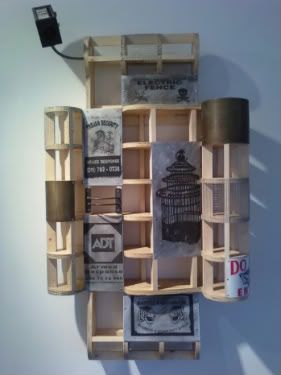

We still fear Africa, by Andries Fourie
Question, Memory
Andries Fourie deals with South African identity at the DIVA
by Suzi Steffen
Personal history converges with national history in one of the strongest shows ever presented at the Downtown Initiative for the Visual Arts.
Artist Andries Fourie grew up in South Africa, the scion of many generations of Afrikaaners. He traces his family to 1680, when his ancestor Louis Fourie arrived in the area, and his heritage — the food, the dances, the music — hold meaning for him, but he’s well aware of the other legacies of Afrikaaner history. He lived it, growing up in the ’70s and ’80s, leaving when he was 21 for the U.S.
His show embraces the complexity of history, his and the country he once called home. The show’s title, “From the Heart of Darkness to the Rainbow Nation: South African Reinvents Itself,” scratches the surface of the conversation Fourie says he needs to have with U.S. viewers. “An American audience generally needs a lot of context when looking at my work,” he says, but he adds, “There are a lot of parallels between American and South African history.”
Walk in and look at Birds of South Africa hanging on the south wall. On the polished aluminum, see the silhouettes of birds in black — birds like the hoephoep, the piet-my-vrou and others, with their Afrikaans names painted beside them. The words in white, with no bird silhouettes, spell the names of black South African languages: Sesotho, Siswati, IsiNdbele, Khoi. Below the aluminum hangs a rifle. The birds were and are hunted, of course, and their names, like everything else, rewritten in the occupiers’ languages — also hunted and nearly erased, certainly in Fourie’s young life.
At his grammar school, Fourie says, the boys learned to shoot on the school’s shooting range. He and the other boys wore military uniforms to school once a week, and when he grew old enough, he was conscripted into the army during a time of civil war, when he and other white teens with guns were sent into black townships.
Last summer, Fourie took part in an artists’ workshop in Namibia, which, when he was a young man, was occupied by South Africa and where he was almost sent to fight against independence movements.
What came out of his time this summer is the piece The brotherhood of meat-eaters. As a vegetarian, I thought the work with its jackal, its half-cow, its bones, a commentary, something along the lines of “man is wolf to man.” Fourie laughs when I tell him. Instead, he says, it’s more a remark upon commonalities: “Afrikaaners always wanted to see ourselves as Europeans, but there are many aspects and language of our culture that are quite African,” he says. South Africans of different races can disagree about almost everything, he says, “but the one thing everybody agrees on is meat.”
At the workshop, jackals cried at night outside the mud huts where the artists slept, and Fourie thought about stories his sheep-rancher grandfather told about keeping jackals away from the sheep.
As a rural kid, he says, he grew up playing games with the ankle bones of sheep; something he says the black South African kids in rural areas also know. So he brought ankle bones back into the U.S., and three of them feature prominently in Brotherhood.
Fourie says that despite the nearly 20 years since apartheid officially ended, not enough has changed. We still fear Africa, the one piece that might be called “preachy” (which he says he fears is a weakness of his work in general — I disagree), features the warnings of electronic security systems. OK, yes, that’s obvious … except that it isn’t.
Fourie says with some amount of surprise and pain that his family members live in compounds, behind those security fences, in all-white enclaves. All-white but for the servants, that is: “I went back three years ago, and my father still had a black woman living in an aluminum tool shed in his back yard, a domestic servant, in the middle of Johannesburg, a huge, modern city.”
Fourie’s Belemmering (Impediment) deals with his personal history as well as the history of colonization, not only in South Africa but also the Congo. On the sculpture, he has placed aluminum panels showing several things, among them a counting rhyme about black South Africans, in Afrikaans, that he likens to “Ten Little Indians” and a panel from Tintin with the eponymous main character explaining in French to Congolese school kids, “I am going to speak to you today of your country, Belgium.”
“You have to question everything about the way you were raised,” Fourie says, because the Nationalist Party mythologized and created “fake history.” Rejecting the racist parts of his past has led to some quite painful experiences: “I’ve had people tell me, ‘You can’t consider yourself one of us anymore,’” he says. “You aren’t even allowed to call yourself Afrikaans.”
In his art, up through Dec. 24 at the DIVA, 110 W. Broadway, Fourie deals with the competing demands of nostalgia and guilt. Don’t miss this show (and see a longer Q&A with the artist on the blog).